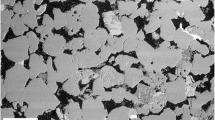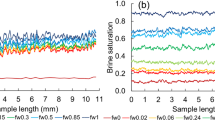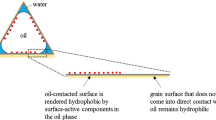Abstract
To provide quantitative data for the development of underground hydrogen storage in porous sedimentary rocks, capillary pressures and relative permeabilities have been measured for the hydrogen–water system. The tests have been performed on a Triassic sandstone. Two potential underground hydrogen storage conditions (“shallower”: 55 bar, 20 \(^{\circ }\hbox {C}\) and “deeper”: 100 bar, 45 \(^{\circ }\hbox {C}\)) have been investigated. Capillary pressure curves have been measured following a modified semi-dynamic technique. The data have been combined with mercury injection capillary pressure measurements to derive a model for capillary pressure valid over almost the entire water saturation range. Interfacial tensions and contact angles for the hydrogen–water system have been also derived. Relative permeability curves measured with the steady-state technique yield low values for minimum water saturations of \(\sim \) 40%. When combined with the capillary pressure data, the relative permeability of hydrogen in sandstone can be evaluated for almost the total range of water saturation. Capillary numbers calculated for our relative permeability experiments indicate a capillary-limited flow regime for the hydrogen–water system. Despite the two differing sets of conditions investigated and this flow regime, the relative permeability curves stay very close from each other, an effect attributed to the almost constant viscosity of hydrogen under our pressure and temperature conditions. This is in contrast with other fluid pairs (e.g., \(\hbox {CO}_{2}\)–water system) where capillary numbers can strongly vary with pressure and temperature. Similarly, capillary pressure data vary little between the experimental conditions. The interpretation of the results would suggest that the relative permeability and capillary pressure results from this study are applicable to a wide range of pressure and temperature conditions.










Similar content being viewed by others
References
Akbarabadi, M., Piri, M.: Relative permeability hysteresis and capillary trapping characteristics of supercritical CO\(_2\)/brine systems: an experimental study at reservoir conditions. Adv. Water Resour. 52, 190–206 (2013)
Al-Menhali, A., Niu, B., Krevor, S.: Capillarity and wetting of carbon dioxide and brine during drainage in Berea sandstone at reservoir conditions. Water Resour. Res. 51(10), 7895–7914 (2015)
Aquilina, L., Pauwels, H., Genter, A., Fouillac, C.: Water-rock interaction processes in the Triassic sandstone and the granitic basement of the Rhine Graben: geochemical investigation of a geothermal reservoir. Geochim. Cosmochim. Acta 61(20), 4281–4295 (1997)
Bai, M., Song, K., Sun, Y., He, M., Li, Y., Sun, J.: An overview of hydrogen underground storage technology and prospects in China. J. Petrol. Sci. Eng. 124, 132–136 (2014)
Basniev, K.S., Omelchenko, R.J., Adzynova, F.A.: Underground hydrogen storage problems in Russia. In: Essen, Proceeding WHEC (2010)
Bader, A.G., Thibeau, S., Vincké, O., Jannaud, F.D., Saysset, S., Joffre, G.H., Copin, D.: CO\(_2\) storage capacity evaluation in deep saline aquifers for an industrial pilot selection. Methodology and results of the France Nord project. Energy Procedia 63, 2779–2788 (2014)
Busch, A., Amann-Hildenbrand, A.: Predicting capillarity of mudrocks. Mar. Pet. Geol. 45, 208–223 (2013)
Carden, P.O., Paterson, L.: Physical, chemical and energy aspects of underground hydrogen storage. Int. J. Hydrog. Energy 4(6), 559–569 (1979)
Crotogino, F., Donadei, S., Bünger, U., Landinger, H.: Large-scale hydrogen underground storage for securing future energy supplies. In: 18th World Hydrogen Energy Conference, pp. 16–21 (2010)
Decourt, B., Lajoie, B., Debarre, R., Soupa, O: Leading the energy transition: hydrogen-based energy conversion. Paris, France: Schlumberger Business Consulting (SBC) Energy Institute (2014)
Després, J., Mima, S., Kitous, A., Criqui, P., Hadjsaid, N., Noirot, I.: Storage as a flexibility option in power systems with high shares of variable renewable energy sources: a POLES-based analysis. Energy Econ. 64, 638–650 (2016)
Ganzer, L., Reitenbach, V., Pudlo, D., Panfilov, M., Albrecht, D., Gaupp, R.: The H2STORE project-experimental and numerical simulation approach to investigate processes in underground hydrogen reservoir storage. In: EAGE Annual Conference and Exhibition Incorporating SPE Europec. Society of Petroleum Engineers (2013)
Gupta, R., Basile, A., Veziroglu, T.N. (eds.): Compendium of Hydrogen Energy: Hydrogen Storage. Distribution and Infrastructure. Woodhead Publishing, Sawston (2015)
Haffen, S., Géraud, Y., Diraison, M.: Geothermal, structural and petrophysical characteristics of Buntsandstein sandstone reservoir (Upper Rhine Graben, France). In: Proceedings World Geothermal Congress, Melbourne, Australia, pp. 1–11 (2015)
HyUnder: D(4)—Overview on all known. Underground storage technologies for hydrogen. Grant agreement no. 2/93. 14.08.2013. 303417
Krevor, S., Pini, R., Zuo, L., Benson, S.M.: Relative permeability and trapping of CO\(_2\) and water in sandstone rocks at reservoir conditions. Water Resour. Res. 48(2) (2012)
Le Gallo, Y., Fillacier, S., Lecomte, A., Munier, G., Hanot, F., Quisel, N., Rampnoux, N., Thomas, S.: Technical challenges in characterization of future CO\(_2\) storage site in a deep saline aquifer in the Paris basin. Lessons learned from practical application of site selection methodology. Energy Procedia 4(2011), 4599–4606 (2010)
Lenormand, R., Eisenzimmer, A., Delaplace, P.: Improvements of the Semi-Dynamic method for capillary pressure measurements. In: SCA-9531 in Proceedings of the 1995 International Symposium of the SCA, San Francisco, CA, pp. 12–14 (1995)
Lord, A.S., Kobos, P.H., Borns, D.J.: Geologic storage of hydrogen: scaling up to meet city transportation demands. Int. J. Hydrog. Energy 39(28), 15570–15582 (2014)
Manceau, J.C., Ma, J., Li, R., Audigane, P., Jiang, P.X., Xu, R.N., Tremosa, J., Lerouge, C.: Two-phase flow properties of a sandstone rock for the CO\(_2\)/water system: core-flooding experiments, and focus on impacts of mineralogical changes. Water Resour. Res. (2015). https://doi.org/10.1002/2014WR015725
Müller, N.: Supercritical \(\text{CO}_{2}\)-brine relative permeability experiments in reservoir rocks—literature review and recommendations. Trans. porous. media. 87(2), 367–383 (2011)
Ozarslan, A.: Large-scale hydrogen energy storage in salt caverns. Int. J. Hydrog. Energy 37(19), 14265–14277 (2012)
Paterson, L.: The implications of fingering in underground hydrogen storage. Int. J. Hydrog. Energy 8(1), 53–59 (1983)
Pfeiffer, W.T., Bauer, S.: Subsurface porous media hydrogen storage-scenario development and simulation. Energy Procedia 76, 565–572 (2015)
Pini, R., Benson, S.M.: Simultaneous determination of capillary pressure and relative permeability curves from core-flooding experiments with various fluid pairs. Water Resour. Res. 49(6), 3516–3530 (2013)
Raballo, S., Llera, J., Pérez, A., Bolcich, J.C., Stolten, D., Grube, T.: Clean hydrogen production in patagonia argentina. Report Nr.: Schriften des Forschungszentrums Jülich/Energy & Environment (2010)
Ramakrishnan, T., Capiello, A.: A new technique to measure static and dynamic properties of a partially saturated porous medium. Chem. Eng. Sci. 16(4), 1157–63 (1991)
Reitenbach, V., Ganzer, L., Albrecht, D., Hagemann, B.: Influence of added hydrogen on underground gas storage: a review of key issues. Environ. Earth Sci. 73(11), 6927–6937 (2015)
Reynolds, C.A., Krevor, S.: Characterizing flow behavior for gas injection: relative permeability of CO\(_2\)-brine and N\(_{2}\)-water in heterogeneous rocks. Water Resour. Res. 51(12), 9464–9489 (2015)
Schaber, K., Steinke, F., Mühlich, P., Hamacher, T.: Parametric study of variable renewable energy integration in Europe: advantages and costs of transmission grid extensions. Energy Policy 42, 498–508 (2012)
Toth, J., Bodi, T., Szucs, P., Civan, F.: Convenient formulae for determination of relative permeability from unsteady-state fluid displacements in core plugs. J. Pet. Sci. Eng. 36(1), 33–44 (2002)
Yekta, A., Audigane, P., Pichavant, M.: Geochemical reactivity and migration of pure hydrogen through sandstone: application to geological storage. 24e Réunion des Sciences de la Terre PAU, France (2015)
Yokoyama, Y., Lake, L.W.: The effects of capillary pressure on immiscible displacements in stratified porous media. In: Paper Presented at SPE 10109 SPE Annual Technical Conference and Exhibition, Society of Petroleum Engineers, San Antonio, Texas, 5–7 Oct (1981)
Zhou, D., Fayers, F.J., Orr Jr., F.M.: Scaling of multiphase flow in simple heterogeneous porous media. SPE Reserv. Eng. 12(03), 173–178 (1997)
Acknowledgements
This research has been supported by ISTO (Institut des Sciences de la Terre d’Orléans), BRGM (Bureau de Recherches Géologiques et Minières) and University of Orleans. We would like to thank Catherine Lerouge from BRGM for helping in the collection of the samples at the quarries in the Vosges area and Remi Champallier from ISTO for helping to prepare the experiments instruments.
Author information
Authors and Affiliations
Corresponding author
Appendices
Appendix A: Protocol to Compute the Core Inlet Saturation from Core-Flooding Capillary Pressure Data
This protocol has been proposed by Ramakrishnan and Capiello (1991) for evaluating the non-wetting phase saturation at the core inlet with core-flooding capillary pressure measurements. As explained before, during capillary pressure measurement just gas is injected to the saturated core sample. Therefore, Darcy’s law (Eq. 2) at steady-state conditions will be:
where x is the position variable along the core, \(\frac{\mathrm{d}P_\mathrm{c} }{\mathrm{d}x} \) the variation of the capillary pressure along the core, \(k_\mathrm{r,g} \) the relative permeability of the gas phase which is a function of the water saturation, s, \(\mu _\mathrm{g}\) the viscosity of the gas, \(Q_\mathrm{g} \) the flow rate of the gas phase, K the absolute permeability, and A the cross-sectional area of the core. Since saturation is varying along the core, the capillary pressure and relative permeability to gas are changing as well. However, since the pressure drop through the core is very small compared to the fluid pressure, the volumetric flow rate and the viscosity can be assumed constant along the core. Therefore, integrating equation (A1) along the length of the core gives:
where \(P_\mathrm{c,x=0} \) corresponds to the capillary pressure measured during the measurements and \(P_\mathrm{c,x=L} \) to the capillary pressure at the outlet of the core, considered as the entry capillary pressure of the rock. By noting \(\Delta P_\mathrm{c,x} =P_\mathrm{c,x} -P_\mathrm{c,x=L} \) (the capillary pressure difference between one location along the core and the core outlet), Eq. (A2) becomes:
Assuming a homogeneous relative permeability law along the core, differentiation of Eq. (A3) relatively to \(\Delta P_\mathrm{c,x=0} \) gives:
This equation means that the relative permeability of gas can be obtained if the relationship between the flow (or injection) rate and the differential pressure measured during the capillary pressure experiments is known.
In parallel, the average saturation in the core can be computed as:
Combined with Eq. (A1), this leads to:
The differentiation of this equation relatively to \(\Delta P_\mathrm{c,x=0} \) gives:
Equations (A7) and (A4) can be changed into:
In other words (with \(v_\mathrm{inj} \) being the Darcy velocity, equal to Q / A):
where
and \(S_\mathrm{w} \left( {\Delta P_\mathrm{c,x=0} } \right) \) is the water saturation at the inlet. Therefore, with information on the injection rate, the differential pressure between the inlet and outlet of the core, and the average saturation in the core during the measurements, it is possible to retrieve the water saturation at the inlet.
However, in order to use Eq. (A9), precise knowledge of the relationship between Darcy velocity (\(v_\mathrm{inj} )\), average saturation (\({\bar{S}}_\mathrm{w} )\) and measured capillary pressure (\(\Delta P_\mathrm{c,x=0} )\) is required. This relationship was obtained by fitting second-order polynomials of \(v_\mathrm{inj} {\bar{S}}_\mathrm{w} \) as a function of \(\Delta P_\mathrm{c,x=0} \) for experiments no1 and no 2, respectively (Table 2; Fig. 11). These polynomials were used to calculate the water saturation at the inlet for each experiment (Fig. 12).
Appendix B: Calculation of Relative Permeability of the Non-wetting Phase from Core-Flooding Capillary Pressure Data
Relative permeability data for the non-wetting phase were extended toward low water saturations by using the capillary pressure data obtained from the core-flooding measurement. This method was suggested by Pini and Benson (2013) based on the work of Ramakrishnan and Capiello (1991). The relative permeability of the non-wetting phase can be calculated from the relationship between the Darcy velocity (\(v_\mathrm{inj} )\) and the capillary pressure (\(\Delta P_\mathrm{c,x=0} )\). Starting with Eq. (A10), we have:
which can be rewritten as:
Relative permeabilities were obtained by fitting second-order polynomials of \(v_\mathrm{inj} \) as a function of \(\Delta P_\mathrm{c} \) for experiments no 1 and no 2, respectively (Table 2). These polynomials were used to extend the relative permeability data for experiments no 3 and no 4 (Fig. 8). Relative permeabilities calculated using the polynomials for experiments no 1 and no 2 are given in Table 4.
Rights and permissions
About this article
Cite this article
Yekta, A.E., Manceau, JC., Gaboreau, S. et al. Determination of Hydrogen–Water Relative Permeability and Capillary Pressure in Sandstone: Application to Underground Hydrogen Injection in Sedimentary Formations. Transp Porous Med 122, 333–356 (2018). https://doi.org/10.1007/s11242-018-1004-7
Received:
Accepted:
Published:
Issue Date:
DOI: https://doi.org/10.1007/s11242-018-1004-7






